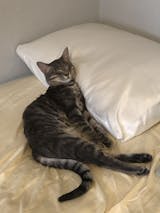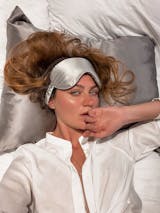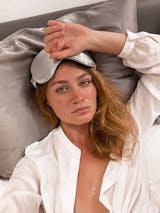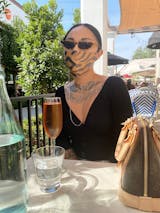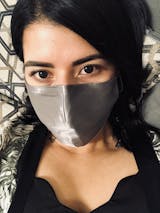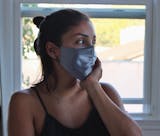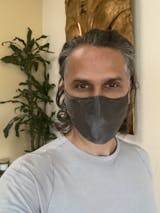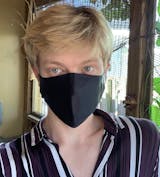If you’ve been to Asia you may have noticed that it’s virtually impossible to buy facial cream without added skin whitener. If your skin is already light, then this isn’t a problem for you. But for brown-skinned beauties who are proud of their dark complexion—it certainly is.
Lightening lotions are the tip of the iceberg. They are simply the symptom of a much bigger problem involving colonized Eurocentric beauty standards that plague the beauty and skincare industry globally.
In this article, we take a look at the issues arising in Asian beauty standards, where they come from, and why they exist.
Why Do People Think East Asian Beauty Standards Are Racist?
In short, because they are. But more importantly—why are they? And why aren’t Asian women encouraged to be proud of their Asian features? We’ll get into that, but let’s first delve into Asian beauty standards and why they are Eurocentric, and racist.
If you have ever ventured anywhere in Asia, the obsession with Eurocentric facial and bodily features, beauty standards, Western culture and lifestyle is pretty obvious. It’s hard to ignore, and impossible to escape. All over Asia you will find indigenous people and native Asian women glorifying Eurocentric beauty standards and lifestyles.
Is it any wonder that people think that East Asian beauty standards are racist when they promote features that are nothing like their native natural standards? All the way from lightening skin, to surgery that elongates faces and chisels pronounced Eurocentric noses—the colonized standards of beauty in Asia are impossible to ignore.
Eurocentric Beauty Standards In Asia
What exactly are Eurocentric beauty standards? Well, the interesting thing with beauty standards is that some are universal, and some are geographically dependant. For example, when in white-dominated countries you are conditioned with a variety of different beauty standards depending on the audience. But there are some central standards…
A Quick List Of Western Beauty Standards
Thin And Tall Body Frame
Until the rise of Jennifer Lopez and the Kardashians, thin bodies were all the rage. And in many ways they still are. Models like Kate Moss, and those who graced the catwalk for brands like Victoria Secret were idolized and revered for their dainty bodies.
Combining the delicate frame with the height is definitely a western beauty standard that is revered in places like Asia where the women tend to be on the curvier and shorter side. Who knew that leg-lengthening surgery was a thing?
Curvy bodies are being idolized now as well, but a tall thin frame has always been desirable as a mainstream beauty standard. Idolized curvy bodies are still somewhat marginalised for minority beauty standards, as opposed to the general mainstream beauty standard.
Light Skin Tones
Light skin was a beauty standard that dates all the way back to Victorian times and beyond. In Victorian times women used toxic makeup that contained mercury, lead, and arsenic to keep their faces looking pale and white. They also used gloves and umbrellas to stay out of the sunlight as white skin was a sign of high status.
This idea that white and light skin represents wealth and high status is still present to this day, especially in black and brown dominated countries. Light skin and a pale complexion is meant to translate as a relaxed and luxurious lifestyle that doesn’t involve working out in the sunny fields.
Ironically, the more recent display of wealth in first world western countries is, you guessed it, dark skin. For those with light complexions in western white dominated countries, dark skin signifies wealth as it means you can afford to take time off work to go on holiday to beautiful exotic, and sunny countries.
This is definitely one of the more worrying colonized beauty trends that we see playing out in black and brown dominated countries because the whitening chemicals within skincare products to lighten skin tone are often toxic (3). Clinical research has found steroids, mercury, and hydroquinone within skin lightening products—all of which are toxic.
Narrow, Long, Faces With High Cheek Bones And Elongated Noses
Long, oval faces with perfectly defined high cheek bones, sharp jawlines, and slim, elongated noses with upturned ends are the western beauty standard. This has resulted in face surgery becoming extremely popular in Asia. Genetically, a wider face shape is more common for Asian women, so women are going to the extent of having surgery to shave down their cheekbones so that they can sport a thinner face.
Full And Plump Lips
Full plump lips are now a ‘western beauty standard’, but they are a culturally-appropriated beauty standard on the whole. It is not common for Eurocentric looking women to have large lips, this is in fact common for mainly black women and often East Asian women.
Full lips are popular in terms of Eurocentric standards, but it is not generally a naturally occurring feature for white or caucasian women to have voluptuous lips. More often than not women are turning to lip fillers to achieve this look.
This is a great example of colonized beauty ideals. Where aspects of people of color are dismantled from their roots and idolized, all the while alienating the marginalized groups that hold them.
Shiny, Sleek, Wavy, Light Colored Hair
Having hair that isn’t poker straight or an afro is a common western beauty standard. This has lead to Asian women curling their hair to add more texture, and black women chemically straightening their hair in an attempt to remove the texture.
Furthermore, women of color often bleach and dye their hair to lighten it. Dark brown and black is the most common hair color for women of color, but lighter browns are blondes are preferred in western beauty standards.
Blue, hazel, green, or grey eyes are idealized. Essentially any other color that isn’t dark brown is seen as ideal. Needless to say, dark brown eyes are the most common color for women of color.
An interesting study on mainstream beauty standards found that Asian women were more likely to align to mainstream beauty standards than black women. And they were more likely to behave like white women and endorse the mainstream beauty standards.
The study also found that Asian women were more likely to feel insecure about their own bodies due to mainstream beauty standards than black women. And interestingly, the black women in the study didn’t feel the mainstream standards were relevant to them in the first place (1). This highlights how alienated and marginalised black women have been from mainstream global beauty standards.
The History Of Eurocentric Beauty Standards
The homogenization of beauty is regarded as the process of creating a uniform standard. The start of the homogenization of beauty started back in the 15th century during western colonialism (4). During the process of colonization people of color were deemed as savages that needed to be tamed and civilized. And the process of colonized and Eurocentric standards began.
The homogenization and colonization of beauty standards has since continued across the globe due to ongoing reinforcement of these ideals and standards through media, advertising, marketing—and more.
So Why Are Asian Beauty Standards Racist?
European imperialism ensured that Eurocentric traits, features, and standards were seen as superior to those of black and brown people.
Western colonizers needed to ensure that there was a hierarchy for control. And sought to paint Asians as needing to be humanized, tamed, and controlled. Which resulted in the subsequent desire of ‘superior’ Western traits, over Eastern traits.
The erosion of self-esteem ensures modern day slavery. By ensuring that women of color hold low self-esteem, modern day colonization can ensure that they are slaves to a system which doesn’t benefit them. Strong, empowered, independent women are a threat to modern day colonization. It benefits white supremacy to keep women of color disempowered.
Women Of Color-Owned Eco-Friendly Beauty Brands To Support
If you’re interested in elevating the status of women of color, then an easy way to share your privilege and empowerment is to invest into their businesses. Here are some great businesses owned by women of color that you will love.
These brands focus on products which are kind to the earth, whilst also being effective and gentle on the skin. If you’re into natural, organic, zero-waste, sustainable skincare and beauty — then be sure to check these out.
Axiology | Ericka Rodriguez
Dew Mighty | Tiffany Buzzatto
Fait avec Coeur | Yuan Zhang
M.S Skincare | Anit Hora
Nopalera | Sandra Velasquez
Conclusion
Beauty standards are constantly changing and evolving, but some have over-stayed their welcome. As the voices of women of color become louder, the tides are turning, and we are looking for ways to be more representative, more inclusive, more accessible, and more diverse. The changing of societal attitudes to perpetuated beliefs allows us to dismantle the ones that do not serve us so that we can ensure all women feel comfortable and beautiful in their own skin.
Carmen Lee is a certified yoga teacher, childbirth doula, and wellness coach. She educates on womb wellness, sacred wisdom, and ancestral-connected living. You’ll find her passionately advocating radical self-care and transformational self-empowerment through sustainable beauty and self-love rituals.
Some of the products promoted in our blog are from our online store. Many others are brands we have researched and found to be great examples of sustainable, ethical, and innovative brands in their field, and we don't make any profit from mentioning them in our blog. #CollaborationOverCompetition
References:
1. https://www.tandfonline.com/doi/abs/10.1080/15298860309030?journalCode=psai20
2. https://www.learningforjustice.org/magazine/what-is-the-model-minority-myth
3. https://www.tandfonline.com/doi/abs/10.1080/02772248.2011.631925?journalCode=gtec20
4. https://projects.iq.harvard.edu/files/isl/files/occidentalisation_of_beauty_standards_eurocentrism.pdf



